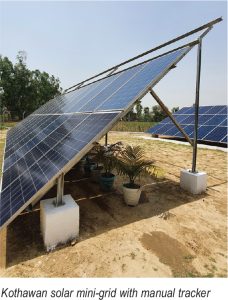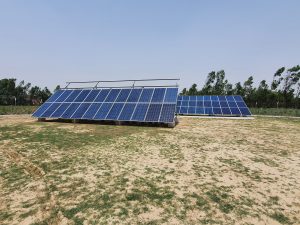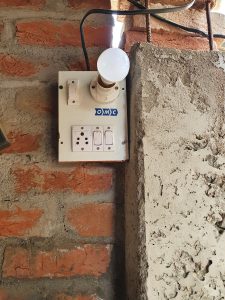By Sarthak Takyar
Apart from the dasheri trees, which are in full flush at the moment, what’s striking about the drive through Uttar Pradesh’s mango belt is the proliferation of standalone solar panels in front of roadside shops, with the traditional transmission lines of the national grid running alongside. I, along with a team from The Rockefeller Foundation, was on a visit to the state’s Hardoi district, to study the need for these single solar panels, despite the existence of the traditional grid, and the impact of solar mini-grids in Pipargaon, Kothawan and Janigaon villages.
Pipargaon solar mini-grid
The first visit was to Pipargaon, located around 49 km from Lucknow. The solar power plant at Pipargaon was established in July 2015. It is an anchor-business-community (ABC) model plant with an installed photovoltaic (PV) capacity of 48.7 kW. The plant has been fitted with a Schneider power electronics suite, custom-made for OMC Power’s specific requirements. Valve regulated lead-acid (VRLA) batteries are being used for this project. Currently, the plant is serving a total of 280 mini-grid customers and one telecom tower.

The mini-grid’s customer base consists of 122 community customers (household) and 158 business customers. At Pipargaon, OMC’s power supply is enabling a plethora of rural entrepreneurs/businesses such as offices, bakery, fuel refilling centres, food corners, clinics, pharmacies, salons, hardware and a variety of other business kiosks. The mini-grid’s customers are served through a network of 72 poles installed and maintained by OMC, covering a length of 2,400 metres.
Telecom customers are served through dedicated underground power supply cables running between telecom towers and the solar plant.
Kothawan solar mini-grid
The next visit was to Kothawan, a small town located around 73 km from Lucknow. The solar power plant at Kothawan was established in December 2020. It is an BC model plant with an installed PV capacity of 22.6 kW. The plant has been fitted with a Statcon Energiaa’s power electronics suite, custom-made for OMC’s specific requirements. VRLA batteries are being used for this project. As on date, the plant is serving a total of 325 mini-grid customers.

The mini-grid’s customer base consists of 127 community customers (household) and 198 business customers. At Kothawan, OMC’s power supply is enabling a plethora of rural entrepreneurs/businesses such as two-wheeler showrooms, gas agencies, fruit shops, tailoring shops, hair cutting salons, beauty parlours, hardware shops, sweet shops and a variety of other business kiosks. The mini-grid’s customers are served through a network of 89 poles installed and maintained by OMC, covering a length of 2,600 metres.

Janigaon guest house solar mini-grid
The last visit was to Janigaon, a small village around 75 km away from Lucknow. The OMC solar power plant at the Janigaon guest house was established in July 2012. It is an ABC model plant with an installed PV capacity of 37.8 kW. The plant has been fitted with a Statcon Energiaa’s power electronics suite, custom-made for OMC’s specific requirements. VRLA batteries are being used for this project.

The solar plant serves 294 mini-grid customers, comprising 281 packages and 13 metered connections. The American Tower Corp. is a telecom customer of the plant, to which the power is supplied through a dedicated underground telecom cable running between the telecom tower and the plant.
In addition, the power supply is also enabling a plethora of rural entrepreneurs/businesses such as banks, carpenter shops, sweet shops, grocery stores, cosmetics/ confectionery vendors, general stores and government-approved customer service centres through a network of 89 poles covering approximately 3,200 metres. The plant also serves as OMC’s central warehouse, a repair centre for electronics/diesel gensets and a battery revival hub.


ABC business model
OMC Power has developed the ABC model, which covers anchor loads, business customers and community households. The business model is explained in detail in a case study titled “Operational Use of Anchor Load Business Community Model Solar Mini-Grids Uttar Pradesh, India”, jointly developed by the International Solar Alliance and the New Energy and Industrial Technology Development Organisation, with the support of OMC Power.
- In this nomenclature, “A” denotes the anchor loads (usually telecom towers) that provide for stable, long-term, predictable revenues through power purchase agreements (PPAs). PPA durations typically range from 10 to 15 years. To hedge against rising diesel costs, the price of a PPA is typically partly indexed to the diesel price. Bankable PPAs, guaranteed anchor loads and early cash flows make the tower segment an essential part of the ABC model.
- “B” stands for essential businesses and commercial customers, such as small and medium enterprises, shops and small shopping centres, malls, banks, fuel stations, hospitals, and colleges. Some larger commercial customers, such as petrol pump operators, sign bankable PPA arrangements, similar to the mobile towers.
- “C” denotes community households. Rural household customers can choose between different prepaid power packages for lighting, mobile charging and other appliances. Most rural households can now afford reliable clean electricity, many for the first time. Some relatively better-off customers go straight to larger prepaid packages or even metered connections of 2 kW and beyond, while others replace their kerosene budgets with the lowest-priced package, which provides one light emitting diode light bulb and a mobile charging (LED) socket for six hours every evening.

Discussions during the field visit provided several interesting insights into the business model and operations of the company. Earlier, solar lanterns were provided to homes, but as technology progressed, the focus shifted to connectivity to homes. The objective is the same – to provide electricity access to rural markets and replace carbon-emitting applications such as kerosene and diesel gensets.
The base package, which costs around Rs 125, provides 15 W of power. The price goes up according to the customer’s need. Earlier, 12 W used to be sufficient for charging phones. Now, with the advent of fancier phones, charging needs alone have increased to 20-30 W. Many households are, in fact, willing to let go of their lighting needs for mobile charging sockets. There are post-paid customers as well, who have better creditworthiness. The Hero Honda showroom we visited falls under this category. However, around 95 per cent of all customers are prepaid.

Around 40 per cent of the company’s total customers are community households. As men are still pursuing agriculture and working at brick kilns, the majority of the benefits of energy access through the solar mini-grids goes to women and children. “Working with the Government of India, and partners like Tata Power and OMC, we know that we can transform the lives of millions of people and bring good jobs to rural communities. We see huge potential for women’s empowerment, innovations in agricultural technology and improving livelihoods for nano, small and medium enterprises. The enthusiasm and leadership from the community members that I met, especially the women, to use clean energy to change their future is deeply inspiring,” says Elizabeth Yee, executive vice president, program strategy and chief of staff, The Rockefeller Foundation. Alongside the evolved ABC model solar pumps, cold storage and other agriculture-based appliances are being provided as services, benefiting men as well.
The company only sells power to the three ABC customer segments and not to the national grid, and has no plans to do so in the future.
Uttar Pradesh Mini-grid Policy, 2016
“The mini-grid policy of Uttar Pradesh is the first of its kind globally and has been emulated by various other states in India and other countries, including Nigeria and Kenya, to frame their mini-grid policies,” says Jaideep Mukherji, chief executive officer, Smart Power India.
The Uttar Pradesh government had issued a mini-grid policy to promote renewable energy-based decentralised generation and encourage private sector participation before the draft national policy was released by the Ministry of New and Renewable Energy. It addresses strategies for mini-grid players to coexist and collaborate with the discoms, and specifies an exit policy in case of the arrival of the grid. Another positive of the policy is giving operators the right to determine tariffs based on mutual agreements between the operators and end-customers. The policy provided clarity to investors, making them willing to take the risk and enter the mini-grid space in the state.
“The Uttar Pradesh government was very progressive and the regulations were in sync with the objectives of the policy,” adds Deepali Khanna, vice-president, Asia, The Rockefeller Foundation.
The projects we visited, however, had not received subsidies under the Uttar Pradesh policy, according to Arindam Sengupta, chief sales and marketing officer, OMC Power. The company still benefited from the policy, as it established the key rules of the game and raised investor confidence.
Key operational challenges
Sengupta explains that as the company operates in rural areas and not urban and semi-urban areas, the equipment used should be rugged and immune to the prevailing weather conditions, pilferage and risk of frequent technology changes. The second key challenge, according to him, pertains to the training of human resources, as the company makes sure to hire people from the same village where the plant is being set up. On an average, two people are hired per plant. Not only does this help in rural employment, the hired villagers also act as brand ambassadors who bridge trust gaps with the rest of the village. The third challenge pertains to theft of electricity. “The risk of electricity theft from our own grid infrastructure (poles) is present, but we have established a monitoring mechanism through which we learn how much electricity is being produced and what the optimum level of the customer’s consumption is, as most are prepaid customers. When the demand suddenly spikes, an alarm is raised,” says Sengupta.


The fourth challenge is the fact that the company still has to rely on diesel gensets on rainy/foggy days, when solar generation is not optimal. To solve this issue, the company is contemplating replacing diesel gensets with biogas/bio-CNG plants and installing more batteries to store solar energy.
For mini-grid players, the elephant in the room is the scenario where the quality of power from the national grid improves, such that their customers stop availing of their services. “This risk does exist; therefore, to counter it we are moving to an evolved ABC model in which we identify different utilities that run on electricity such as cold storage, electric vehicle charging and clean water plants, and provide additional services to the customer apart from basic electricity access,” says Sengupta. Apart from providing uninterrupted power during the productive hours of business communities and households, the company also provides lifetime free services covering boards, wires from poles and bulbs, because of which customers find value in the company’s offerings despite the rate disparity with the power available from the national grid.
To a question posed by Yee, Sengupta explains that customers are located within 2-2.5 km of a solar mini-grid to avoid transmission losses, and extensive surveys need to be undertaken before selecting a village and customers. To another question asked by Yee on the issue of non-payment by customers, Sengupta replied that that is not a major hurdle, and in a month, only 0.5 per cent of accounts fail to pay. There is a gestation period of three months for these customers. If they are unable to pay in that time frame, services are withdrawn.
The way forward
OMC Power’s current portfolio comprises 280 plants. Its target is to set up another 1,000 plants by the end of 2023. The focus will remain on Uttar Pradesh, as the company feels that only the surface has been scratched there.
According to Khanna, scale is very important in the mini-grid space. The sector received a big boost when in 2019 Tata Power collaborated with Smart Power India and aimed to set up 10,000 mini-grids. Smart Power India has partnered with other developers, including Husk Power, Tara Urja, Hamara Grid and MLINDA, and aims to set up 12,000 mini-grids collectively with its partners in the coming years.
“We have provided a total of $3 million-$4 million under two programme-related investments to OMC Power directly in the form of debt financing. The first financing was in 2016-17 and the second one was more recent,” shares Khanna. This financing is conditional and should be used for the B (essential business) and C (community households) customers in OMC Power’s ABC model. “The learnings in India have helped us develop similar models in Myanmar and Africa and, going forward, it will help us in our latest venture with the Bezos Earth Fund and the IKEA Foundation, called Global Energy Alliance for People and Planet,” she adds.
In a bid to provide energy access to rural India and make it carbon-free, different models will be experimented with apart from mini-grids. “We have already launched a new programme on rooftop solar for the small-scale commercial and industrial sector in rural areas to replace diesel usage. We are catalysing finance and persuading developers to enter this sector. While the demand is fragmented, with individual low capacities, the aggregate number of customers is in millions,” says Mukherji.

